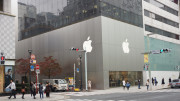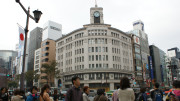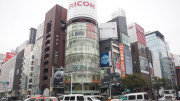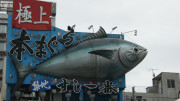Ginza is Tokyo’s fashion capital, much like Fifth Avenue in New York or Bond Street in London. It is home to many of the world’s most prestigious fashion houses and luxury brands. Sometimes referred to as “The Ginza,” the precinct also boasts some of the world’s most expensive real estate and is a place where the wealthy come to see and be seen. For many companies, having a Ginza storefront is as much a statement of success as it is a business venture.
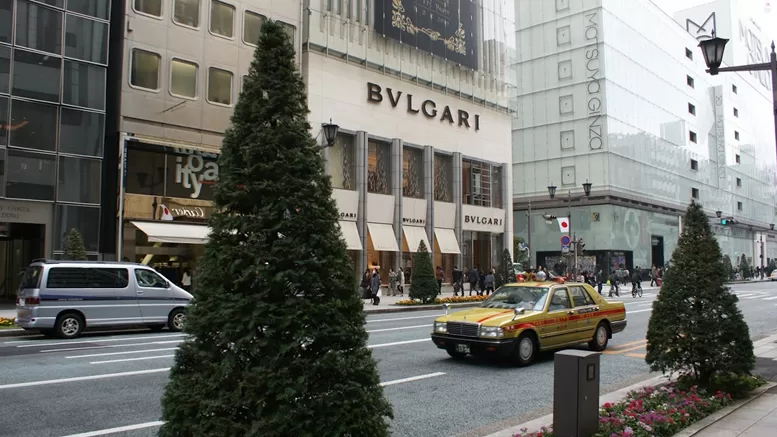
Ginza is renowned for its high-end department stores, including Matsuya, Matsuzakaya, Wako, and Mitsukoshi, all located along Chuo Dori alongside global luxury brands such as Cartier, Chanel, and Bvlgari. Even Apple chose Ginza for its first store in Japan, opening on Chuo Dori. Here, Apple products are as much a fashion statement as they are technology. Like the five-story glass Apple store, many buildings along Chuo Dori are architectural masterpieces, showcasing cutting-edge designs with glass, steel, and dazzling lighting effects.
Hotels & Dining in Ginza
Ginza is also home to luxury hotels, including Hotel Seiyo Ginza, Hotel Monterey, Ginza International, and Courtyard Marriott, among others. The area is a gastronomic hotspot, with renowned restaurants such as Iron Chef Michiba Rokusaburo’s Rokusan-tei and Hiroyuki Sakai’s La Rochelle, located on the 32nd floor of the Toho Seimei Building. For coffee lovers, Ginza Café Paulista is a must-visit. Located in the Nagasaki Centre on Ginza 8-9, this historic café dates back to 1909 and was a favourite of John Lennon and Yoko Ono during their visits to Tokyo.
Exploring Ginza
Ginza consists of eight blocks, from 1-Chome to 8-Chome, with Chuo Dori as its central and most prestigious avenue. This wide, tree-lined boulevard is closed to traffic on weekends, attracting tens of thousands of visitors who come to shop, people-watch, and soak up the lively atmosphere. Al fresco seating is set up in the street, allowing visitors to relax, read, or simply enjoy the surroundings.
During the day, Ginza offers a refined, elegant experience, but at night, it transforms into a neon-lit spectacle, with giant video billboards and vibrant advertisements lighting up the skyline. The area’s iconic intersection at Chuo Dori and Harumi Dori, home to Wako, Mitsukoshi, and the Nissan Gallery, is one of the most photographed spots in Tokyo.
Despite its reputation for luxury, Ginza is not just for the ultra-wealthy. There are plenty of affordable shops, restaurants, and hotels, making it accessible for all visitors. Even if you don’t plan to shop, it’s worth visiting just to admire the extravagant window displays and immerse yourself in the atmosphere.
For a remarkable food experience, explore the basements of Ginza’s department stores, where you’ll find some of the most incredible gourmet markets in Japan. Here, you can purchase a variety of beautifully prepared dishes for just a few hundred yen—a feast for both the eyes and taste buds.
Access
Ginza is easily accessible by rail, with Ginza Station serving as the main hub. This massive underground station is connected to the:
- Marunouchi Line (M16)
- Ginza Line (G09)
- Hibiya Line (H08)
Alternatively, you can reach Ginza by walking a few blocks from Yurakucho Station, served by:
- JR Yamanote Line
- JR Keihin-Tohoku Line
- Tokyo Metro Yurakucho Line (Y18)
At the other end of Chuo Dori, Shimbashi Station is another excellent entry point. This station connects to:
- JR Yamanote Line
- Tokaido Main Line
- Keihin-Tohoku Line
- Tokyo Metro Ginza Line (G08)
- Toei Asakusa Line (A10)
Just outside Shimbashi Station, you’ll also find the starting point of the Yurikamome Line, an elevated train that takes you to the island of Odaiba.
Whether you visit Ginza for its shopping, dining, nightlife, or just to experience the electric atmosphere, it remains one of Tokyo’s must-visit destinations. For the best experience, plan your trip on a weekend to take part in the open-street festivities, and stay until nightfall to witness the district’s stunning neon transformation.

